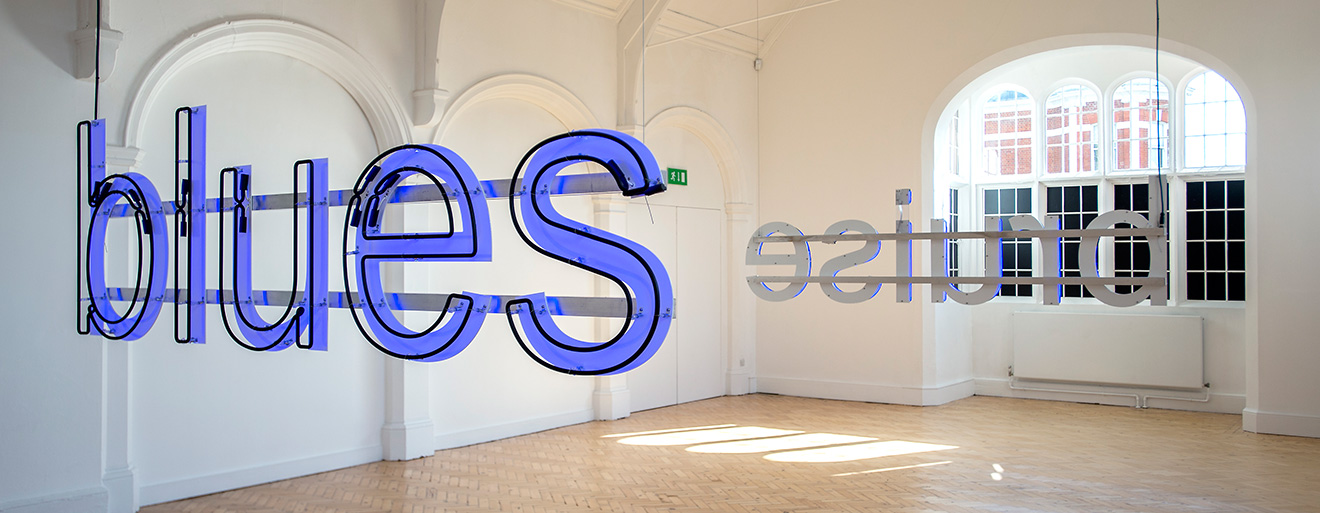Johannesburg
17 March - 15 April 2016Glenn Ligon
Untitled (Bruise/Blues)

Installation view of Call and Response, Camden Arts Centre, 2015
Photo: Valerie Bennett. Courtesy of Regen Projects, Los Angeles
STEVENSON is pleased to present Untitled (Bruise/Blues) (2014), a neon installation by Glenn Ligon. The work was presented at his exhibition Call and Response at the Camden Arts Centre in London in 2014, and a similar work was shown at the central exhibition of the 2015 Venice Biennale, All the World’s Futures, curated by Okwui Enwezor.
In Untitled (Bruise/Blues), suspended letters spell out the words 'bruise' and 'blues', blinking on and off. The work takes as its point of departure composer Steve Reich’s seminal 1966 recording Come Out, in which Reich loops the voice of Daniel Hamm, one of the Harlem Six – a group of black youths beaten and wrongfully arrested during the 1964 Harlem Riot. In the recording Hamm is heard saying, 'I had to, like, open the bruise up, and let some of the blues blood come out to show them' – a slip of his tongue replacing 'bruise' with 'blues'. At the time the violent treatment the Harlem Six received at the hands of the police sparked widespread criticism from people like Malcolm X and James Baldwin, two figures whom Ligon continues to reference in his work.
Megan Ratner writes in the catalogue for Come Out, Ligon's Camden Arts Centre exhibition: 'Ligon's paintings directly reference the Harlem Six, but were made 50 years later, in an America of escalating inequality at every level. Coming out means acknowledging national truths too.'
Text-based work has been at the centre of Ligon's oeuvre as a means to explore sexuality, identity and history. In the past he has used fragments from the pages of writers such as Baldwin, Zora Neale Hurston and Gertrude Stein to create paintings, prints and neon sculptures. Ligon says about his use of text:
Words are pictures the way I paint them. I'd agree that there is a tension between the meaning of the words and the form of the paintings. That's what's interesting to me. The paintings are about the desire to communicate and a certain pessimism about the possibility of doing that. I know that the texts I use are not iconographic, but they do exist outside of my paintings; they are available to be read. Making a painting, for me, is akin to making a film adaptation of a text: it's just one possible way out of many of responding to a given text. - Glenn Ligon, Yourself in the World
This is the third time Stevenson has shown Ligon's work in South Africa. In 2010, on the eve of the World Cup, Stevenson presented a solo exhibition in its Cape Town gallery consisting of a neon text work, the 2008 video Death of Tom and several text paintings, including one based on Richard Pryor’s 'I went to Africa …' joke. In 2012 three drawings by Ligon were included in What we talk about when we talk about love, an exhibition curated by Federica Angelucci about the complexity of love in all its forms. For Stevenson it is a particular privilege to build on this sustained engagement with the current project.
The history that informs Untitled (Bruise/Blues) resonates strongly with recent cases of police brutality in the United States and South Africa. The deaths of Trayvon Martin, Michael Brown and Eric Garner sparked widespread protests and debate about the institutional racism that permeates the American police force. In South Africa the killing of 34 striking miners at Marikana in 2012 is freshly embedded in our memory, and has been followed by other reports of incidents of casual use of violence by members of the SAPS. The use of a 'white human shield' by protesting UCT students last year to protect themselves from the batons of the riot squad highlighted deeply ingrained police behaviour that treats white and black bodies differently. More broadly, Untitled (Bruise/Blues) confronts further parallels between the US and South Africa, such as the after-effects of erasure and displacement, and the continued presence of violence, both immediate and systemic, decades after the dismantling of legal discrimination.
Ligon was born in the Bronx, New York, in 1960, and in 1985 participated in the Whitney Museum of American Art's Independent Study Program. His work is included in the Obamas' choice of artworks currently on loan to the White House, making him the youngest artist ever to be exhibited there. He is also the latest recipient of the Joyce Alexander Wein Artist Prize. Ligon's work has been the subject of exhibitions throughout the United States and Europe. His survey exhibitionAMERICA showed at the Whitney Museum of American Art, New York; Los Angeles County Museum of Art and the Modern Art Museum of Fort Worth in 2011-12. In 2014 Ligon’s first UK solo show, Call and Response, was exhibited at Camden Art Centre. He co-curated Glenn Ligon: Encounters and Collisions at Nottingham Contemporary and Tate Liverpool in 2015, the year that he was invited to show at the 56th Venice Biennale. His work is represented in many public collections including the Museum of Contemporary Art, Chicago; the Museum of Modern Art, New York; the Philadelphia Museum of Art, Philadelphia; the Guggenheim Museum, New York; the Tate Modern, London; the Walker Art Center, Minneapolis; and the Whitney Museum of American Art, New York.
A selection of Jane Alexander's black-and-white photomontages made between 1981 and 1995 will show concurrently in the second gallery.
The exhibition opens on Thursday 17 March, 6 to 8pm.

